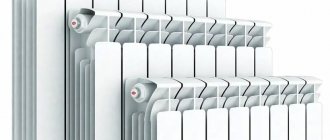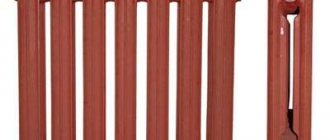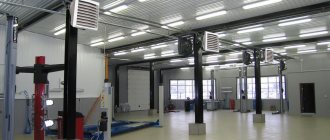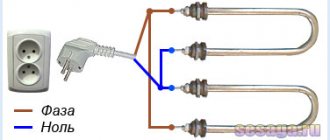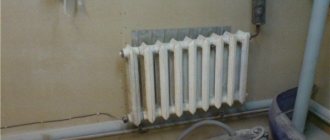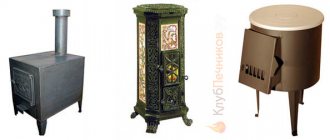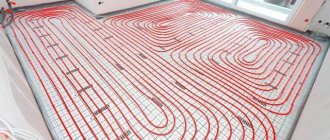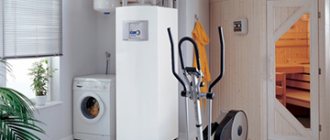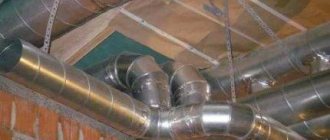Correct calculation of air conditioner power is the key to efficient, uninterrupted operation and durability of climate control equipment. The choice of performance is based on the overall dimensions of the room and related factors contributing to the accumulation of thermal radiation.
Taking into account all the parameters and nuances of operation allows you to provide an optimal power reserve, but at the same time not overpay for the super-performance of the split system.
But how to correctly perform the necessary calculations? We will consider this issue in detail in our article. In addition to the two methods for calculating power, we will focus on other important criteria that influence the choice of air conditioner.
What do the power values in the documentation say?
The technical documentation for air conditioners indicates two or three types of power. The indicators characterize different operating parameters: cooling and heating capacity, as well as the electrical power consumed by the split system.
The range of indicators can be misleading. In heating electrical appliances, such as a boiler or radiator, the heat output corresponds to the energy consumed. For an air conditioner, these parameters are different.
A split complex, unlike a heater, does not directly convert electricity, but uses it to operate a heat pump. The latter is capable of pumping much more heat energy than the electrical power consumed.
An example of displaying power characteristics in the passport for a Lennox GHM09 air conditioner operating in two modes: cooling and heating
Cooling capacity is the main technical characteristic that determines the ability of an air conditioner to remove heat outside the building. Power consumption is interesting from the point of view of selecting the supply cable and planning costs
Cooling power is indicated in kW, the range of values for household equipment is 2-8 kW. In addition, many manufacturers use the British marking - BTU (BTU) in technical descriptions.
The cooling capacity of the split unit must correspond to the service conditions. Otherwise, normalizing the microclimate to a given temperature will become an impossible task for the air conditioner and will damage the equipment.
There are two possible scenarios:
- low productivity - the unit operates at the limit of its capabilities;
- excess power - an increase in the number of on/off switches, which has a detrimental effect on the electric motor.
The ability to heat a room characterizes the heat output of a split. The heat transfer power is always slightly higher than the cooling capacity. The difference between the indicators is the ratio of heat loss along the freon pumping route in cooling and heating modes.
The thermal power indicator is especially relevant if the air conditioner is planned to be used as an interseasonal heating source. A split complex is many times more efficient than an electric heater. We talked about the features of a split system for heat here.
For 1 kW of electricity consumed, modern air conditioners produce about 3.6-5.5 kW of heat. This volume is enough to heat a living area of 36-55 sq.m., respectively.
Calculation of power consumption and energy costs
The value of the power consumed by the air conditioner allows you to determine whether it can be connected to a regular outlet or whether you need to pull a separate cable to the electrical panel. In modern houses, electrical wiring and sockets are designed for currents up to 16A, but if the house is old, then the maximum current should not exceed 10A. For safe operation, the current consumed by the split system must be 30% less than the maximum permissible, that is, equipment whose operating current does not exceed 7–11A can be plugged into the outlet, which corresponds to a power consumption of 1.5–2.4 kW
(note that with such energy consumption, the cooling power of the air conditioner will be in the range of 4.5–9 kW). It must be taken into account that in apartments several sockets are connected to one cable, so to calculate the actual load you need to sum up the power of all electrical appliances connected to the sockets of one line.
The exact value of the power consumed by the air conditioner and its operating current are indicated in the catalogue. Since we do not know which model will be selected, we calculate these parameters based on the average value of the ERR coefficient.
Knowing the power consumption, we can estimate energy costs. To do this, you need to set the average operating time of the air conditioner per day at a certain power, for example, 2 hours at 100%, 3 hours at 75%, 5 hours at 50% and 4 hours at 25% (this operating mode is typical for hot weather). After this, you can determine the average energy consumption per day and, multiplying it by the number of days in the month and the cost of kWh, get the cost of electricity consumed per month. The average daily energy consumption of an air conditioner depends on the air temperature set by the user, the nature of the weather and other factors that are difficult to take into account, so our calculation does not claim to be highly accurate.
After choosing a specific split system model, you will be able to clarify the expected energy consumption (how to do this is described in the Power consumption section).
| Types of air conditioners | Top | Features and Specifications |
BTU value and labeling explanation
BTU/BTU is a British Thermal Unit for measuring heat energy. The value determines the amount of heat expended to heat one pound of water by 1° Fahrenheit.
It is this unit that expresses the refrigeration capacity of climate control equipment and is often present in product labeling.
Ratio between Watts and BTU/h:
- 1 BTU/h ≈ 0.2931 W , for ease of calculation, use 0.3 W;
- 1 kW ≈ 3412 BTU/h.
Air conditioning is an American invention that uses Western systems of measurement. For practicality and clarity of display, it was decided to standardize the cooling capacity and express it in round numbers, for example: 7000 BTU/h, 9000 BTU/h, etc.
Split models have corresponding names: “seven”, “nine”, etc. Thus, the LG GO7ANT air conditioner belongs to low-power units - “sevens”. Its performance is 2.1 kW
Understanding the digital designation in the equipment labeling, you can approximately determine for which room the air conditioner is designed.
Calculation methods and formulas
It is quite logical for a scrupulous user not to trust the numbers obtained from an online calculator. To check the result of calculating the power of the unit, use the simplified methodology offered by refrigeration equipment manufacturers.
So, the required cold performance of a household air conditioner is calculated using the formula:
Explanation of symbols:
- Qtp – heat flow penetrating into the room from the street through building structures (walls, floors and ceilings), kW;
- Ql – heat release from apartment residents, kW;
- Qbp – heat input from household appliances, kW.
It is easy to find out the heat transfer of household electrical appliances - look at the product data sheet and find the characteristics of the electrical power consumed. Almost all of the energy consumed is converted into heat.
Important point. An exception to the rule is refrigeration units and units operating in start/stop mode. Within 1 hour, the refrigerator compressor will release into the room an amount of heat equal to 1/3 of the maximum consumption specified in the operating instructions.
The compressor of a home refrigerator converts almost all the electricity consumed into heat, but operates in a periodic mode.
Heat gains from people are determined by regulatory documents:
- 100 Wh from a person at rest;
- 130 Wh - while walking or doing light work;
- 200 W/h - for heavy physical activity.
For calculations, the first value is accepted - 0.1 kW. It remains to determine the amount of heat penetrating from the outside through the walls using the formula:
- S – quadrature of the cooled room, m²;
- h – ceiling height, m;
- q – specific thermal characteristic related to the volume of the room, W/m³.
The formula allows you to perform an enlarged calculation of heat inflows through the external fences of a private house or apartment using the specific characteristic q. Its values are taken as follows:
- The room is located on the shady side of the building, the window area does not exceed 2 m², q = 30 W/m³.
- With average illumination and glazing area, a specific characteristic of 35 W/m³ is taken.
- The room is located on the sunny side or has many translucent structures, q = 40 W/m³.
Having determined the heat input from all sources, add up the resulting numbers using the first formula. Compare the results of your manual calculation with those of an online calculator.
A large glass area means an increase in the cooling capacity of the air conditioner.
When it is necessary to take into account the heat input from ventilation air, the cooling capacity of the unit increases by 15-30% depending on the exchange rate. When updating the air environment once per hour, multiply the calculation result by a factor of 1.16-1.2.
Electricity consumption and energy efficiency assessment
As noted above, in addition to cooling and heating capacity, the power consumption is indicated in the split system passport. The value determines the energy consumption. We recommend that you familiarize yourself with the rules for calculating electricity consumption and ways to save it.
However, the coefficient and energy efficiency class are more informative.
EER and COP are indicators of the energy efficiency of the air conditioner in cooling and heating modes, respectively. The value is calculated by dividing the cooling or heating capacity by the power consumption
Essentially, the EER and COP show the amount of cold/heat produced when 1 kW of electrical power is consumed. The higher their numerical value, the higher the efficiency of the climate system and the lower the level of energy consumption.
That is, at EER=2.5 , the air conditioner at maximum cooling power consumes Q/2.5 . By multiplying the result by the operating period, you can find out the daily energy consumption.
Based on EER, splits are classified into energy efficiency classes. Category “A” includes the most economical units, group “G” represents air conditioners with the highest electricity consumption.
There are three additional premium classes that characterize energy-saving climate control equipment. A worthy representative of group A+++ - split complex MSZ-LN60VGR from Mitsubishi Electric
Air conditioner power: what it is and what it affects
An air conditioner has two powers - cooling power and power consumption. Both are measured in watts (W) and are listed in the device's specifications, but there are major differences between them.
Cooling power is a measure of the intensity with which the device cools the room. It can be indicated in W or other units - BTU (BTU). These are British thermal units, which also reflect the efficiency of the air conditioner.
Power consumption or electrical power is the amount of energy required to operate a device. It is measured in W, and is always less than the cooling power. Power consumption affects the electricity bill, but not the operating efficiency.
To calculate the power of the air conditioner and electricity consumption, a separate parameter is used - the efficiency indicator. This is the ratio of cooling power to power consumption. It is denoted by the abbreviation ERR, or indicated in BTU, where 1BTU is conventionally equivalent to 0.3W of power consumption.
It is important to understand the parameters of the air conditioner Source irp-cdn.multiscreensite.com
Methods for self-calculation of power
There are several ways to calculate the performance of splits. The simplest, but not reliable enough, is calculation by area. A more accurate method is the thermotechnical method, which takes into account the design features of the room and the total heat inflows.
Option #1 - choosing an air conditioner based on service area
You can determine the approximate power of the unit without mathematical calculations, using a practical assessment criterion - the area of the room.
The average cooling capacity of a split is 1 kW per 10 sq.m of service room. This standard is relevant for residential premises with a ceiling height of 2.5-3 m.
Thus, when calculating the power of the air conditioner, the service area must be divided by 10. For example, for a room of 22 sq.m., a model with a capacity of 2.2 kW is suitable. The resulting value corresponds to “seven” according to the BTU system.
The calculated power is increased by 20% in the following cases:
- location of the room on the sunny side of the house;
- the presence of panoramic windows;
- placement of a large number of office equipment and electrical appliances.
A cooling capacity reserve of 20% must be provided if many people constantly live or work in the room.
When choosing climate control equipment for spacious rooms of 60 square meters or more, industrial or commercial buildings, the direct dependence of cooling power on area no longer works
Due to the impressive dimensions, possible angularity and curvature, air flows are distributed unevenly. In this case, it is advisable to install multi-system split complexes.
Option #2 - use thermal calculation
Thermal engineering calculations taking into account the design and operational features of the building are considered more accurate. Next, consider the typical formula used for calculations.
Determining factors:
- room dimensions: area and exact height;
- number of people;
- purpose of the premises: gym, active work, recreation, etc.;
- heat sources, household/office equipment;
- the presence of insulated facades and roofs.
The main emphasis in assessing the power of an air conditioner is on the total heat gain.
The proposed thermal calculation method is applicable for office premises, separate rooms of private houses and apartments in permanent buildings. Area restrictions – 70 sq.m.
The greater the heat flow, the higher the cooling capacity of the split should be.
Typical formula:
Q=Q1+Q2+Q3,
Where: Q – final cooling power; Q1 – heat input from the structural elements of the room; Q2 – heat inflow from people; Q3 – heat generation from equipment.
Step #1 – Calculate Q1
The heat excess of a room is determined as follows:
Q1=V*g,
where: V is the volume of the serviced premises, calculated by multiplying the square footage and the height of the ceilings; g – calculated heat transfer coefficient.
The value of the g indicator depends on the orientation of the windows and the level of natural light in the room:
- 40 – sunny side, intense insolation is typical for southern, southwestern, southeastern orientation;
- 35 – moderate illumination on the eastern, northwestern, western side;
- 30 – the predominance of shading during the day is observed in rooms whose windows face north or northeast.
As you can see, the sunny side will have the highest heat transfer coefficient.
Step #2 – Define Q2
The heat production of people depends on their age and mobility.
The following heat release indicators are typical for an adult:
- rest state – 80 W;
- light work, moderate loads – 125 W;
- vigorous activity – 170 W.
When performing hard work and intense sports exercises, heat production reaches 250 W.
For a more reliable assessment, the heat inflow of children under 12 years of age is taken with a coefficient of 0.5, for children under 17 years of age - 0.75
However, this approach is justified when choosing a split system for children's institutions. The air conditioner is purchased for the future, so for a family, the heat transfer of children should be equated to “adult” indicators.
For an apartment cooling system, parameter Q2 is determined by the product of the number of residents and the average heat release value - about 110 W.
Step #3 – calculation of Q3
Excess heat from electrical equipment is calculated using the formula:
Q3=N*m*i,
Where:
- N – power of a unit of equipment;
- m – number of household appliances;
- i – coefficient of conversion of electricity into heat.
In the calculations, it is necessary to take into account the frequency of use of equipment during the day, taking round-the-clock work as a unit.
Energy transfer coefficients for different equipment are given in the table. Additional heat gain values: TV - 0.2 kW, copy machine, computer - 0.3 kW, other lighting/household appliances - 30% of rated power consumption
By summing up the total amount of heat inflow, you can determine the power of the air conditioner. It is permissible to exceed the cooling capacity of the unit by 15% of the calculated value or reduce it by a maximum of 5%.
How to calculate power using calculators
If you have neither the desire nor the time to do calculations, then you can use the services of some Internet resources that have special calculators. In theory, of all the methods, this should combine the optimal simplicity/accuracy ratio, but in practice, not everything is so simple. We don’t know what algorithms are embedded in the program code, we don’t know which heat sources are taken into account and which are not. Some resources, based on the results of verification, provide indicators with a significant margin, which will force you to overpay when purchasing.
Calculator for calculating air conditioner power by room area
Skip to calculations
For these reasons, we recommend using calculators only for rough calculations. If you are not “scared” by the power reserve, then calculators will help you quickly calculate the level of ventilation and other characteristics that you have not even thought about.
These resources will also help you choose the type of air conditioner depending on the room in which it will be installed.
Video - Calculation of air conditioner power
Step-by-step calculations of equipment power
First, let's calculate the required equipment power for a specific room with an area of 24 sq.m. And then we’ll look at the situations in which adjustments are used.
Power calculation for a specific room
Calculation data for determining split performance:
- room area – 24 sq.m, ceiling height – 2.8 cm;
- a room with a standard window facing south;
- number of residents – 2 people;
- equipment: computer, TV, refrigerator (0.3 kW), incandescent lamp (0.1 kW).
Simultaneous operation of the listed electrical appliances is possible.
Step 1 - determination of heat gains from windows, floors, walls and ceilings.
Q1=24*2.7*40=2592 W
The resulting value can be safely rounded to 2.6 kW. The calculation uses the coefficient g=40, since the room is well lit.
Step 2 - calculating heat gain from people. Let us take the heat production of an adult to be 110 W.
Q2=2*110=220 W or 0.22 kW
Step 3 - heat inflows from equipment are calculated for each type of equipment, taking into account the electricity conversion coefficient:
- computer – 0.3 kW;
- TV – 0.2 kW;
- electric lamp – 90 W (100 W*0.9);
- refrigerator – 100 W (300 W*0.3).
Q3=300+200+90+100=600 W or 0.6 kW
Step 4 - calculating the cooling capacity of the air conditioner.
Q=2.6+0.22+0.6=3.42 kW
For comparison, it is possible to make an approximate selection of an air conditioner solely by area without taking into account the number of residents and heat inflows. For an area of 24 sq.m., the estimated cooling capacity should be 2.4 kW, taking into account good lighting - 2.4 * 1.2 = 2.88 kW.
Based on the initial parameters, it is recommended to select an air conditioner with a power in the range of 3.3-3.9 kW. “Twelve” splits correspond to this value – their productivity is 3.5-3.5 kW
In this situation, the calculation results using the two methods differ. The priority is “thermal” calculation. The cooling power of the air conditioner must extinguish all possible heat gains.
Taking into account special operating conditions
The method described above in most cases does not need adjustment and gives an accurate result.
Deserves special attention:
- the need for regular ventilation;
- location of the room on the top floor;
- hot climate of the region;
- large glazing area.
Let's consider all these cases in more detail.
Fresh air supply
The documentation for split systems usually stipulates that operating the device with open windows is undesirable.
The influx of external air flow entering the room creates an unforeseen thermal load for the climate control equipment. The volume of fresh air is not standardized, and it is difficult to predict in advance the optimal power reserve
To maintain a normal microclimate without constantly moving the sash, you can leave the window on micro-ventilation or install a supply valve. Both options do not provoke drafts when the front door is closed.
When operating the split in conditions of gentle ventilation, the following should be taken into account:
- In order to compensate for the additional heat load, the Q1 indicator when calculating the power of the air conditioner must be increased by 20%.
- Electricity consumption during split operation will increase to 15%.
In hot weather, do not rely on power reserves. If there is significant heat inflow, the air conditioner will not provide the set temperature.
Top floor of living space
In attics and apartments on the top floors without an attic, the heat of the heated roof is transferred into the room. The situation is aggravated with dark-colored flat roofs.
To compensate for heat inflows from the roof, a reserve of cooling capacity is provided - when determining the power of the air conditioner, the value of Q1 is multiplied by a factor of 1.15-1.2
Hot climate of the region
One of the rules for safe use of an air conditioner is to maintain the permissible temperature difference between the outside and inside the building. The limit value is 10 °C. For example, if it is 35 °C outside the window, then the recommended room temperature is not lower than 25 °C.
The rated power of split complexes is indicated taking into account operation in conditions up to 31-33 °C. When the indicator increases to 40 °C or more, the cooling capacity of the unit is not enough to maintain the coveted 18-20 °C.
Taking into account the climate's predisposition to hot summers and one's own preferences for the level of coolness, when calculating, the Q1 indicator should be additionally increased by 20-30%.
Large windows in the room
The standard formula assumes that there is one window in the room of standard dimensions - up to 2 sq.m. Several window openings or a panoramic design increases unaccounted heat gain.
Due to the increased impact of the light flux entering through the windows, in the warm season, climate control equipment spends half the power to compensate for solar heat
The cooling power is adjusted based on each square meter of additional glazing:
- + 200-300 W – for the sunny side;
- + 100-200 W – moderate insolation of the room;
- + 50-100 W – predominance of shading.
Light-colored blinds or curtains will help reduce solar heat gain.
Instructions for using the program
Now we will explain step by step how to calculate the power of an air conditioner using the presented calculator:
- In the first 2 fields, enter the area of the room in square meters and the height of the ceiling.
- Select the degree of illumination (insolation) through the window openings. Sunlight penetrating into the room additionally heats the air - this factor must be taken into account.
- In the next drop-down menu, select the number of residents staying in the room for an extended period of time.
- On the remaining tabs, select the number of TVs and personal computers located in the air conditioning area. During operation, these household appliances also generate heat and are subject to accounting.
- If there is a refrigerator installed in the room, enter the value of the electrical power of the household appliance in the penultimate field. The characteristics can be easily found in the product instruction manual.
- The last tab allows you to take into account the supply air entering the cooling zone due to ventilation. According to regulatory documents, the recommended multiplicity value for residential premises is 1-1.5.
For reference. The air exchange rate shows how many times within one hour the air in the room is completely renewed.
Let us explain some of the nuances of correctly filling out the fields and selecting tabs. When indicating the number of computers and televisions, take into account the simultaneous operation of them. For example, it is rare for one tenant to use both appliances at the same time.
Accordingly, to determine the required power of the split system, a unit of household appliance is selected that consumes more energy - a computer. The heat dissipation of the TV receiver is not taken into account.
The calculator contains the following heat transfer values from household appliances:
- TV – 0.2 kW;
- personal computer – 0.3 kW;
- Since the refrigerator converts about 30% of the electricity consumed into heat, the program includes 1/3 of the entered figure in the calculations.
The compressor and radiator of a conventional refrigerator release heat to the surrounding air
Advice. The heat output of your equipment may differ from the indicated values. Example: the consumption of a gaming computer with a powerful video processor reaches 500–600 W, a laptop – 50–150 W. Knowing the numbers included in the program, it is easy to select the necessary values: for a gaming PC, choose 2 standard computers, instead of a laptop, take 1 TV receiver.
The calculator allows you to exclude heat gains from the supply air, but choosing this tab is not entirely correct. Air currents in any case circulate throughout the home, bringing heat from other rooms, for example, the kitchen. It’s better to play it safe and include them in the calculation of the air conditioner so that its performance is sufficient to create a comfortable temperature.
The main result of power calculation is measured in kilowatts, the additional result is measured in British Thermal Units (BTU). The ratio is as follows: 1 kW ≈ 3412 BTU or 3.412 kBTU. How to choose a split system based on the figures obtained, read on.
Additional criteria for choosing an air conditioner
In addition to the power characteristics of the system and energy efficiency class, before purchasing, you should decide on the following parameters:
- type of air conditioner;
- operating principle of the unit;
- functionality;
- by the manufacturer.
Next, we will consider each of these criteria in more detail.
Criterion #1 - type of air conditioner
For domestic use, monoblocks and split systems are used. The first category includes window models and compact portable devices. Window-mounted air conditioners have lost their former popularity.
They are being replaced by more modern modifications that do not have the disadvantages of their predecessors: noisy operation, reduced illumination due to window clutter, limited choice of location
The undeniable advantages of window “coolers”: low cost and maintainability. This unit is more suitable for seasonal country use than for an apartment.
Mobile monoblocks are equipped with a flexible air duct that removes heat to the street. A portable air conditioner is the optimal solution for a rented space. We have given the rating of the best mobile models in this article.
Advantages of a mobile monoblock: possibility of transportation, ease of installation. Disadvantages: large dimensions, high noise level, “binding” to the output channel
Split systems confidently occupy a leading position among household air conditioning systems.
Based on the form of execution, there are two categories of splits:
- Two-block design . A pair of modules are connected by a closed freon line. The complex is easy to operate and almost silent. Various design options for the indoor unit are available; the housing does not take up useful space in the room.
- Multi-system . The external module ensures the operation of two to five internal units.
The use of a multi-complex allows you to set different air conditioning parameters in individual rooms.
The disadvantage of the climate system is the dependence of indoor units on a single outdoor unit. If it breaks down, all rooms will be left without cooling.
Criterion #2 - operating principle
There are conventional and inverter models.
The operating procedure of a traditional split system:
- When the temperature rises, the air conditioner turns on.
- After cooling to the designated limit, the unit turns off.
- The on/off duty cycle is repeated continuously.
But an inverter air conditioner operates more “smoothly”. After startup, the room is cooled, but the device continues to operate at reduced power, maintaining the desired temperature.
The inverter version of the split is 30-40% more economical than a conventional air conditioner. The energy efficiency EER value of some models reaches values of up to 4-5.15
Due to the absence of “sharp” cyclical operation, inverter air conditioners are low noise and durable.
You also don’t know what is better to choose – an inverter or a regular air conditioner? In this case, we recommend that you familiarize yourself with their main differences, as well as the pros and cons of each option.
Criterion #3 - features and brand
Manufacturers, in an effort to win the favor of customers, equip split systems with additional options.
It’s good if the air conditioner has the following functions:
- fan distribution of air flow;
- automatic restoration of device settings;
- remote control;
- built-in timer.
Another popular air conditioner function among users is the flow of fresh air. Many manufacturers offer such models.
Air conditioners of popular brands are represented by a wide range of models in different price categories - from budget economy class to split systems in the premium segment
The equipment manufacturer plays a significant role in the choice - the better the brand reputation, the higher the quality indicators and reliability of the equipment.
The ranking of leading manufacturers is dominated by foreign companies: Daikin, LG, Sharp, Hitachi, Panasonic and General Climat. We reviewed the best air conditioner models in the following article.
How an air conditioner works - device design
It is a well-known fact: air conditioners cool the air in a room. To understand how they do this, you will need minimal knowledge of how they work. The air conditioner consists of two main units - an internal one, which is located inside a room or office, and an external one, which is located outside.
The “heart” of the air conditioner is freon (refrigerant). This is a substance that has a high heat capacity, and it is with its help that the air is cooled to the desired temperature. Freon circulates through a closed system between the outdoor and indoor units. In the outdoor unit it is cooled by a fan, in the indoor unit the refrigerant itself cools the air.
Important! The refrigerant circulates in a closed circuit and should not enter the external environment. If this happens, the air conditioner's performance will decrease.
Checking for refrigerant leaks Source metropha.com
The air from the room is also a closed system. The air conditioner cools a certain volume of air to a given temperature and releases it to the external environment. Maximum efficiency is achieved when the windows and doors in the room are closed - then the volume of circulating air is constant.
When the air cools, excess moisture condenses from it - it is this that drips from the outdoor unit onto the street (you can put a special container for it and empty it regularly). An unpleasant side effect of air conditioning is associated with this - the air becomes dry over time. Condensation also creates an environment for bacteria to multiply. To combat negative phenomena, the room must be ventilated daily, and the air conditioner itself must be cleaned regularly (the frequency is indicated in the instructions).
Conclusions and useful video on the topic
Practical recommendations from a specialist will help you determine the power characteristics of the air conditioner:
Understanding the principles of calculating the performance of air conditioning systems, you will be able to independently determine the range of permissible power.
It is better to entrust the final calculation of suitable parameters to professionals - an experienced specialist will take into account all operational nuances and select the optimal air conditioner model.
Do you need an air conditioner, but you don’t want to make a mistake with the power and choose insufficiently efficient equipment for your apartment/house? Maybe you still have questions about the calculations or want to clarify certain nuances? Ask for advice in the comments - our experts and competent site visitors will try to clarify all the points.
Online calculator for calculating cooling capacity
To independently select the power of your home air conditioner, use the simplified calculation method based on the area of the cooled room, implemented in the calculator. The nuances of the online program and the parameters entered are described below in the instructions.
Note. The program is suitable for calculating the performance of household coolers and split systems installed in small offices. Air conditioning of premises in industrial buildings is a more complex task, which can be solved using specialized software systems or SNiP calculation methods.
Examples of calculations
Let's determine the required cooling capacity of an air conditioner for a studio apartment based on the following data:
- area: 32 sq. m;
- ceiling height: 2.5 m;
- room illumination: average (assuming K = 35);
- number of residents: 1 person who periodically engages in physical exercise at home;
- equipment: computer, TV, refrigerator with 400 W compressor;
- special preferences: it is advisable to provide the ability to adjust the device to 20 degrees in any weather conditions.
Owners of air conditioners know that the device cannot be turned on in winter. Then why is there a winter kit for air conditioners? Let's try to figure it out.
You will find recommendations for installing an air conditioner yourself in the following article.
Calculation procedure
- Define Q1:
Q1 = 32x2.5x35 = 2800 W.
Considering the customer’s desire to have the house temperature within 20C under any conditions, we increase Q1 by 25%. Then Q1 = 2800 x 1.25 = 3500 W.
- Define Q2:
Since the apartment is inhabited by one person who regularly plays sports, we take Q2 = 300 W.
- Define Q3:
The heat release from the refrigerator will be 30% of 400 W, that is, 400x0.3 = 120 W.
Since the computer and TV will rarely work at the same time (one person lives in the apartment), in the calculation we will only take into account the heat emission from the “hottest” of them - the computer, which produces 300 W of heat.
Therefore, Q3 = 120 + 300 = 420 W.
- Define Q:
The required refrigeration power will be: Q = 3500 + 300 + 420 = 4220 W = 4.22 kW.
We will select an air conditioner with a refrigeration capacity in the range of 0.95Q - 1.15Q, that is, from 4 to 4.853 kW.
Electricity consumption during the day at EER = 3 will be (4.22/3)x8 = 11.2 kWh.
At current rates, this will cost the user 33.6 - 56 rubles.


